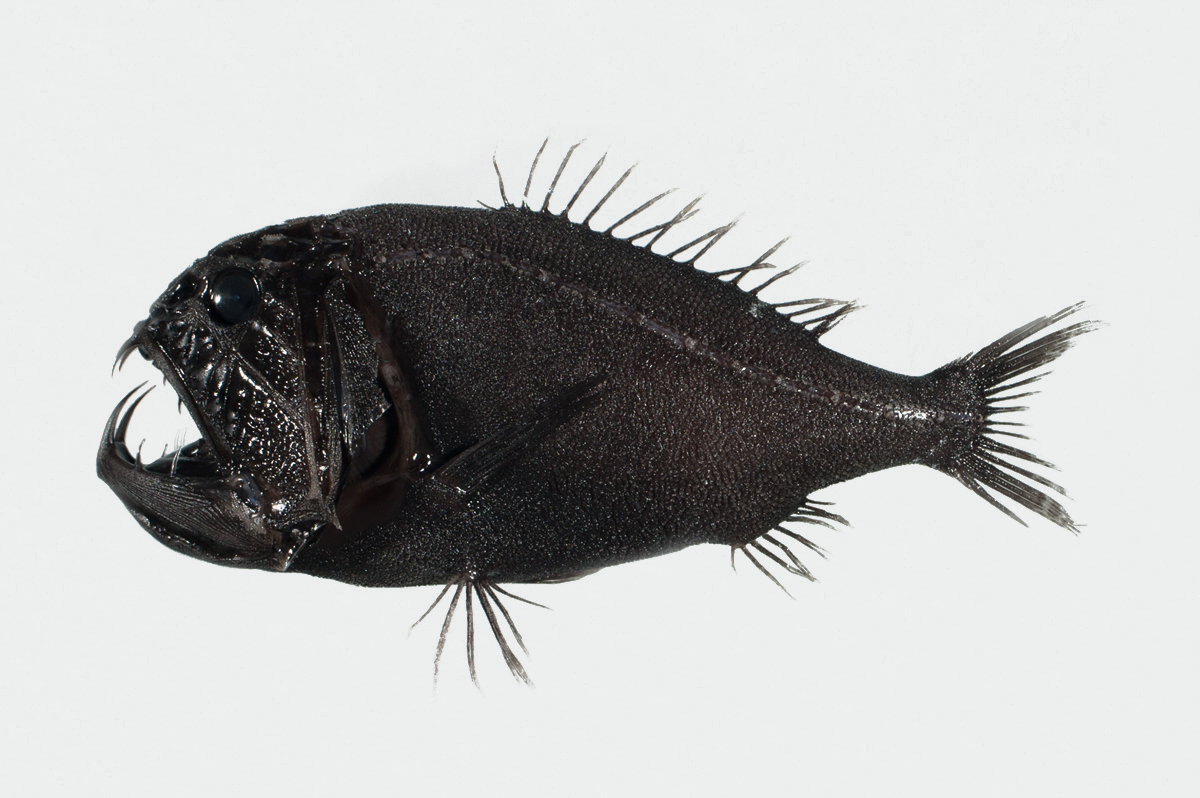Fangtooth, Anoplogaster cornuta (Valenciennes 1833)

A Fangtooth, Anoplogaster cornuta, from near Norfolk Island in the Tasman Sea. Source: Robin McPhee / NORFANZ Founding Parties. License: CC by Attribution-NonCommercial-ShareAlike
Head and body uniformly blackish to dark blackish-brown, with an enormous mouth containing huge fang-like teeth. Juveniles have long prominent spines on the head that decrease in length with growth.
Relative to its size, the Fangtooth has the largest teeth of any fish. When it closes its mouth, the enormous lower jaw teeth slide up into sockets on either side of its brain.Fangtooth, Anoplogaster cornuta (Valenciennes 1833)
More Info
|
Distribution |
Coral Sea off southern Queensland, to off Point Cloates, Western Australia, including Tasmania; also Christmas Island in the eastern Indian Ocean, and the Lord Howe and Norfolk Island provinces in the Tasman Sea. Elsewhere the species is circumglobal, usually in warm temperate to tropical waters, mostly at depths of 500-2,000 m. |
|
Features |
Dorsal fin rays 17–20; Ana fins rays 7–9; Pectoral fin rays 13–16; Pelvic fin rays 7. Body deep, compressed poteriorly; mouth large with huge fang-like teeth; eyes small; mucous cavities on head covered by thin fragile membranes and separated by serrated ridges; gill rakers of adults in spinulate groups on bony bases; dorsal fin long-based, of uniform height, anal-fin short-based; caudal fin skin embedded with small prickly scales; lateral line an open groove, bridged at intervals by scales. Juveniles differ markedly, having a pale body, relatively large eyes, long, vertical head spines and small, multiserial teeth. |
|
Size |
|
|
Colour |
Adults uniformly dark blackish-brown to black, including inside mouth; juveniles pale. |
|
Feeding |
Juveniles feed on crustaceans, while adults feed mainly on fishes. |
|
Biology |
Oviparous, with planktonic larvae. Larval sizes as follows: 3.9mm preflexion, 4.7mm to 9.1mm SL postflexion, and a 15.7mm SL juvenile (Konishi 1999). |
|
Fisheries |
Of no interest to fisheries. |
|
Conservation |
IUCN Red List: Least Concern |
|
Remarks |
|
|
Similar Species |
|
|
Etymology |
The specific name is from the Latin cornutus (= horned) in reference to the long spines on the head of juveniles. |
|
Species Citation |
Hoplostethus cornutus Valenciennes, 1833, Hist. Nat. Poiss. 9: 470.Type locality: South Atlantic, 26°S, 50°W (stomach content). |
|
Author |
Bray, D.J. 2022 |
|
Resources |
Fangtooth, Anoplogaster cornuta (Valenciennes 1833)
References
Anoplogaster cornuta Digital Fish Library http://www.digitalfishlibrary.org/library/ViewSpecies.php?id=56 Accessed 23 April 2017
Bray, D.J. 2008. Family Anoplogastridae. pp. 434 in Gomon. M.F., Bray, D.J. & Kuiter, R.H (eds). Fishes of Australia's Southern Coast. Sydney : Reed New Holland 928 pp.
Childress, J.J. 1973. Observations of the feeding behavior of a mesopelagic fish Anoplogaster cornuta: Beryciformes. Copeia 1973: 602-603.
Grey, M. 1955. Notes on a collection of Bermuda deep-sea fishes. Fieldiana 37: 265-302.
Hulley, P.A. 1986. Family 131: Anoplogasteridae. pp. 415 in Smith, M.M. & Heemstra, P.C. (eds). Smith's Sea Fishes. Johannesburg : Macmillan South Africa xx + 1047 pp. 144 pls.
Iwamoto, T. 2015. Anoplogaster cornuta. The IUCN Red List of Threatened Species 2015: e.T18123960A21910070. http://dx.doi.org/10.2305/IUCN.UK.2015-4.RLTS.T18123960A21910070.en. Downloaded on 21 June 2017.
Konishi, Y. 1999. Developmental and comparative morphology of beryciform larvae (Teleostei: Acanthomorpha), with comments on trachichthyoid relationships. Bulletin of Seikai National Fisheries Research Institute 77: 23-92.
Kotlyar, A.N. 1986. Classification and distribution of fishes of the family Anoplogasteridae (Beryciformes). Voprosy Ikhtiologii 26(4): 531-551 [in Russian; English translation in Journal of Ichthyology 1987 26(4): 133-153]
Meek, R.P. & Childress, J.J. 1973. Respiration and the effect of pressure in the mesopelagic fish Anoplogaster cornuta (Beryciformes). Deep-Sea Research 20: 1111-1118.
Paxton, J.R. 1999. Families Gibberichthyidae, Rondeletiidae, Barbourisiidae, Cetomimidae, Mirapinnidae, Megalomycteridae, Anoplogastridae, Diretmidae. pp. 2203-2211 in Carpenter, K.E. & Niem, T.H. (eds). The Living Marine Resources of the Western Central Pacific. FAO Species Identification Guide for Fisheries Purposes. Rome : FAO Vol. 4 2069-2790 pp.
Roberts, C.D. 2015. 136 Family Anoplogastridae. pp. 1002-1003 in Roberts, C.D., Stewart, A.L. & Struthers, C.D. (eds). The Fishes of New Zealand. Wellington : Te Papa Press Vol. 3 pp. 577-1152.
Valenciennes, A. in Cuvier, G.L. & Valenciennes, A. 1833. Histoire Naturelle des Poissons. Paris : Levrault Vol. 9 512 pp. pls 246-279. See ref at BHL
Watson, W. 1996. Anoplogastridae: fangtooths. pp. 683-685. in Moser, H.G. The early stages of fishes in the California Current region. Fisheries Investigations Atlas No. 33 Lawrence, Kansas : California Cooperative Oceanic Allen Press, Inc. 1505 pp.
Young, J.W., Lamb, T.D. & Bradford, R.W. 1996. Distribution and community structure of midwater fishes in relation to the subtropical convergence off eastern Tasmania, Australia.l. Marine Biology 126(4): 571-584.











